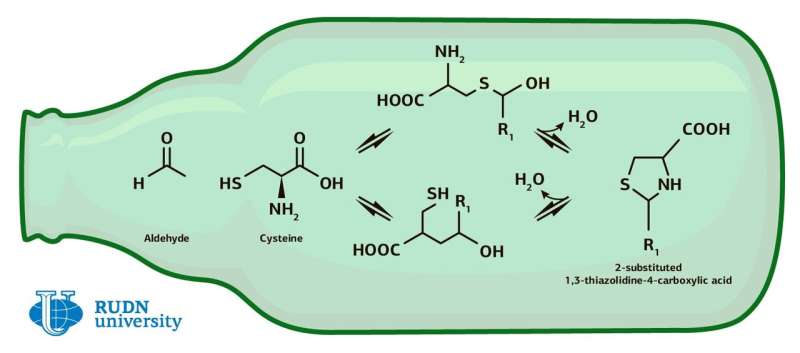Chemist suggests a way to measure the taste of beer

A chemist from RUDN University has developed a method for analyzing the products of binding of aldehydes with the amino acid cysteine in malt and beer—these substances can adversely affect taste during storage. The technique can be used for the routine detection of these substances, which will help prove or disprove their effect on the taste of beer. The results are published in the Journal of Chromatography A.
The flavor of beer becomes less saturated over time after bottling. The new study advances the hypothesis that the deterioration in taste is associated with the reaction products between aldehydes and the amino acid cysteine, which are found in beer raw materials and beer itself. To confirm or refute this idea, it is necessary to determine how much of these substances samples of beer with "good" and "bad" taste contain. If there are less reaction products of cysteine and aldehydes in "bad" beer, it means that these two substances are the ones that spoil the taste. However, reliable methods for detecting the reaction products of aldehydes and cysteine did not exist. Professor Eric Van der Eycken of RUDN University, together with colleagues from Belgium and the Netherlands, developed a chemical analysis technique that solves this problem.
To develop detection methods, the chemists first synthesized seven standard aldehyde samples considered to be markers of beer aging. The researchers studied their structure using nuclear magnetic resonance spectroscopy (NMR), as well as mass spectrometry. Then the samples were checked for impurities using high-performance liquid chromatography (HPLC).
With these samples, the chemists developed a method for their simultaneous identification using liquid chromatography with a mass spectrometric detector (HPLC-MS). This is a selective method that can detect several substances simultaneously among a large number of other compounds, and at a very low concentration, up to 0.4 micrograms per liter.
To valdiate the method, they experimentally confirmed its linearity, sensitivity, convergence, and correctness using samples of pure substances. They proved that the method obtains reliable analysis results in the range from 0.4 to 1000 micrograms per liter. In order to achieve that, the researchers used a chromatographic apparatus to study samples of two varieties of pilsner malt and two varieties of beer: fermented, prepared in a pilot brewery at the Belgian Catholic University of Leuven, and one of the most popular commercial varieties.
As a result of the experiment, the researchers found products of the interaction of seven aldehydes with cysteine in the malt samples, which were not detected in significant concentrations in beer samples; and while they were found in some samples, it was at the limit of detection, which means that their concentration is below the measurement range of the measuring devices.
The fact that the products of the interaction of aldehydes with cysteine were found in the malt samples in significant concentrations, about 500 micrograms per liter, and some of them in the beer samples as well (in very low concentrations, of about 4.2 micrograms per liter), shows that the technique can be used to test the hypothesis about the effect of these substances on the taste of beer.
The technique proposed by the RUDN University chemists can be used for routine detection of these substances in beer and raw materials for beer, which will finally establish if these substances have anything to do with deterioration in the taste of beer.
More information: P. Bustillo Trueba et al. Validation of an ultra-high-performance liquid chromatography-mass spectrometry method for the quantification of cysteinylated aldehydes and application to malt and beer samples, Journal of Chromatography A (2019). DOI: 10.1016/j.chroma.2019.460467
Provided by RUDN University




















